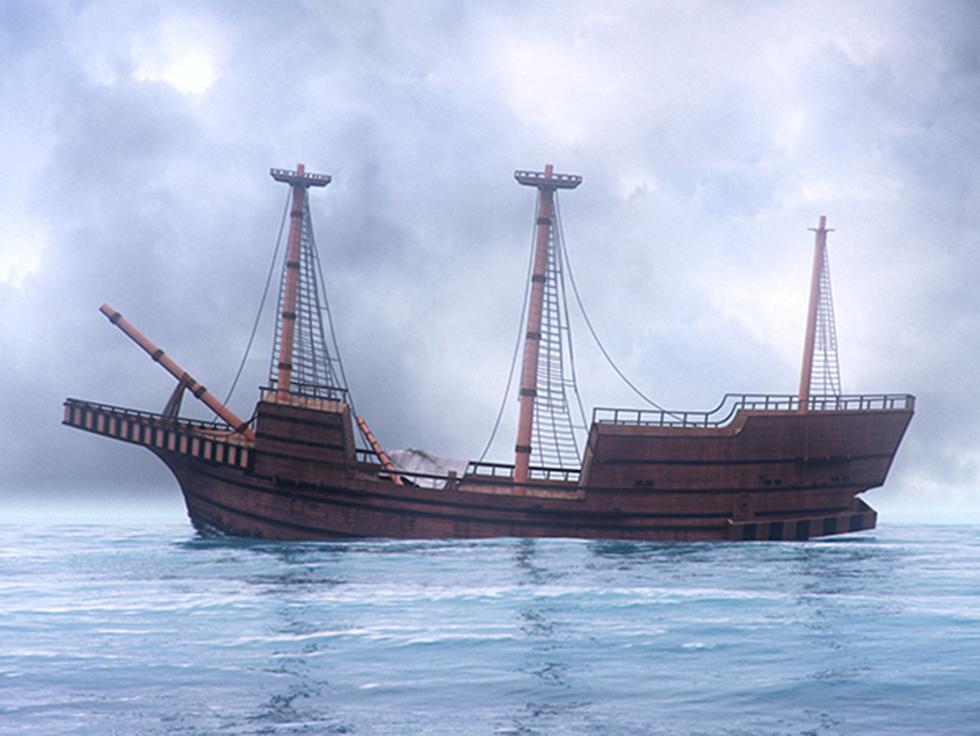Ships: Real and Imagined
Our departmental specialism in maritime archaeology has led to a natural involvement in projects related to the computational reconstruction, testing and visualisation of ships. Some of these are real-world archaeological sites, while others represent ' digital floating hypotheses' of how to solve particular challenges.
Building the 'Apistos'
The Apistos (Unbelievable) Ship Project was undertaken by Dr Julian Whitewright on behalf of Science UK Ltd in advance of Damien Hirst's major exhibition 'Treasures from the Wreck of the Unbelievable' (Venice, 2017). The main aim of the project was to complete the computational reconstruction and subsequent hydrostatic testing of a very-large Roman Period merchant vessel. The only constraints beaing that the ship had to be historically accurate, feasibly seaworthy, and capable of transporting a specified weight of cargo in a variety of unusual dimensions.
Computational reconstruction and testing was done in conjunction with Pat Tanner (3D Scanning Ireland). This combined Julian's expertise in Roman Ship Techology with Pat's experience as a shipwright and leading expert in the digital reconstruction of historic ships from archaeological remains. This process was informed by the archaeology and art of the shipping of the Roman Empire to produce a final design that was 61m in length, with a cargo capacity (displacement) of 1374 tons, and a useable cargo volume of 2140m3.
A further step was then taken with this design being fully visualised by Grant Cox (ArtasMedia Ltd) to allow the technical content underlying the vessel to be more appreciated by the viewing audience. The finished digital plans were then taken by Science UK Ltd and commissioned via Amalgam Modelmaking into a large-scale exhibition model of the reconstructed ship for display at the exhibition in Venice.
Wider work within the project entailed the provision of background historical and archaeological information to allow the exhibition to be fully contextualised. In addition, archaeological advice was given to Oxford Film and Television during their work to create a documentary film about the wreck of the Apistos and the archaeological recovery of its cargo.
The Grace Dieu
At the time of its maiden voyage in 1420 the Grace Dieu was the biggest royal ship ever built in England. Its size was not surpassed for another 200 years. The ship was laid-up in a bespoke mud-dock the River Hamble, near Southampton, in 1434. The ship was struck by lightening in 1439 and a major portion of the hull was destroyed by fire, leaving only elements of the lower hull surviving in an increasingly buried state in the mudflat.
The remains of the ship were rediscovered in the early 20th century and limited archaeological investigation undertaken. In the 2000s cutting edge 3D sub-bottom geophysical equipment was used by the University of Southampton to survey the site and to produce a detailed understanding of the shape of the surviving hull of the ship. This research has formed the basis for the CGI modelling of the ship currently ongoing, and with the intention of providing in impression of what this great ship must have looked like within its final resting place.
CGI visualisation of the site has been carried on behalf of Eastleigh Borough Council out by Grant Cox (Artas Media) with specialist expert input from Prof Jon Adams (hull form and construction) and Dr Julian Whitewright (rigging and sails).
The Sea Venture
Collaborative work between Prof. Jon Adams and ArtasMedia Ltd to provide a CGI reconstruction of the wreck of the Sea Venture on Bermuda in 1609 on behalf of Look Bermuda and Hueristic Media. The Sea Venture was the largest of the supply fleet bound for the newly established English colony in Jamestown, Virginia. Its wreck on the island of Bermuda was the inspiration for Shakespeare's 'The Tempest'.
The wrecksite was rediscovered in the 1980s and surveyed and excavated by a team directed by Jon Adams, founder the Centre for Maritime Archaeology at the University of Southampton. Adams' work allowed the structure and hull shape of a ship of this period to be understood for the first time, on the basis of the combined archaeological and historical record.
The resulting CGI model of the Sea Venture, stuck fast on its Bermudan Reef was incorporated into the pilot Heuristic Shakespeare app 'The Tempest' which launched as part of the 400th anniversary of Shakespeare's death. The model and animation were also used in a short clip for the documentary 'Downing's Wreck: The Story of the Sea Venture'.




